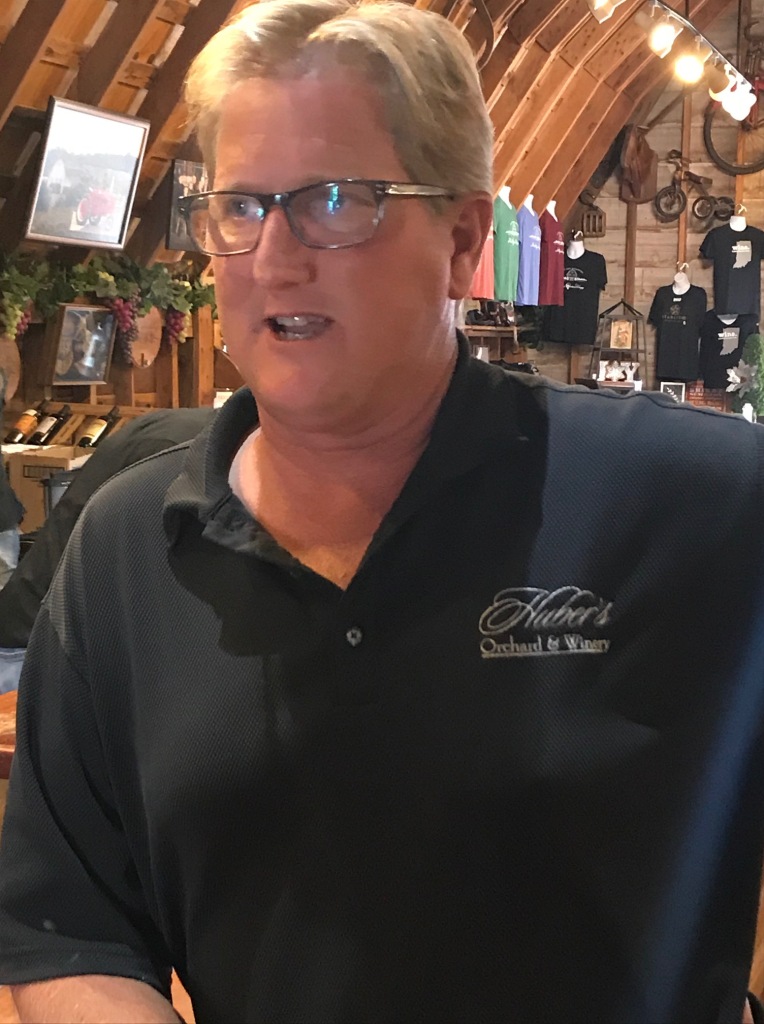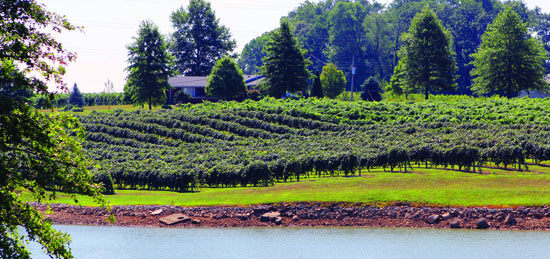Tags
Changing consumer tastes and a growing number of family members has spurred Southern Indiana’s Huber Winery to significant growth.
Wine production, stable around 50,000 cases for several years, neared 70,000 cases this past year. But what’s really impressive is the explosive growth of the distilled spirits business. Huber’s is putting spirits in barrels more than they are bottling and selling. The expectation is they’ll pass the 50 percent mark in the coming few years for finished product, obviously spurring additional growth.
The success is driven by treating wine and spirits the same and capitalizing on Huber’s incredible tourist draw at their winery, distillery, farmer’s market, restaurant, large meeting hall and more.
Visitors to the hilltop winery near New Albany topped 500,000 visitors just a couple of years ago, then 600,000 the following year. Ted Huber said this year the winery had several days when more than 20,000 people passed through the vines, Christmas trees and up to the tasting room. Those numbers make Huber’s Indiana’s most-visited winery.

“Our family sees a lot of success in the spirit market because we treat it exactly like wine,” said President and co-owner at Hubers. “When you have a tasting experience here at winery, you can sit here and enjoy wine and have a great tasting. Guy sitting beside you can be your best friend who hates wine but loves spirits. He has a different shaped glass and whiskey being poured in his glass and has a great time. We treat the tastings the same. We talk about the flavors. Instead of talking about vineyards we’re talking about cornfields. There is a lot of correlation between the two.
Huber started with a small still more than a decade ago making brandy and now business is booming. The whiskey and bourbon products are sold in 20 states. They have three rickhouses (spirits’ barrel storage) and have started construction on a fourth. The rickhouses hold 2400 to 7,000 barrels each.
“Liquor is a little easier for us to ship out of here and get on the shelves than an Indiana wine,“ he said. “We have a lot of people moving away from wine and getting into spirits. People are getting into what goes into those drinks.
“People will say that’ a really good cocktail but why is that Manhattan so different from that Manhattan? And now that they’re in the cocktail market they’re trying some of the main ingredients. Kentucky bourbon or Indiana rye have different flavor profiles. So the consumer is finding that to be very interesting.”
The market growth has coincided with family growth. The sprawling operation is nearly 180 years old with family ownership and control the whole time.
“As the size or his working family has expanded, Huber has been able to experiment more. “My mother is still here, my uncle is still here, my business partner is here and now we have five members of the seventh generation coming on board.
“That takes a lot of space for family members to live on the farm, and work on the farm without getting in each other’s way,” he laughed. “We a legacy farm going on 180 years and we want to continue that. We’ve had to have more opportunities for family members to move into the company.”
As far Huber is concerned, growth has been nonstop. “A construction company has been coming or going since 2013. As long as the economy remains strong, we’ll keep expanding.
Wine lovers take note of one of their boldest moves. “We’re moving into Chardonnay which is brand new for us. We bought a farm that is a great location for Chardonnay. Note he’s not talking about the hybrid Chardonel but the world’s second most-planted grape Chardonnay. Ted’s two sons, Blake and Christian, are crafting a Chardonnay in a French Chablis style – no oak! There is very little, if any, Chardonnay grown in the Hoosier state.
The exciting growth means employment opportunities as well. The winery, orchard and farm employ 75 full-time employees. Employment swell up to 175 during peak seasons.
The future isn’t just about new wines and booming spirits sales. When that fourth rickhouse is complete, the family plans to build a new tasting room combining the wine and spirits tasting opportunities.
Huber’s is often recognized as the state’s best estate grown red wines. When given the chance, try the Cabernet Franc, Malbec, Bordeaux-style Heritage, or Petit Verdot.




 “I was in kindergarten,” 20-year- old Christian said, stifling a laugh. “We had one of those ‘what do you want to do when you grow up?’ things. I wrote down winemaker and my teacher thought, ‘who is this guy?’ His family alcoholics or something?’ “
“I was in kindergarten,” 20-year- old Christian said, stifling a laugh. “We had one of those ‘what do you want to do when you grow up?’ things. I wrote down winemaker and my teacher thought, ‘who is this guy?’ His family alcoholics or something?’ “












